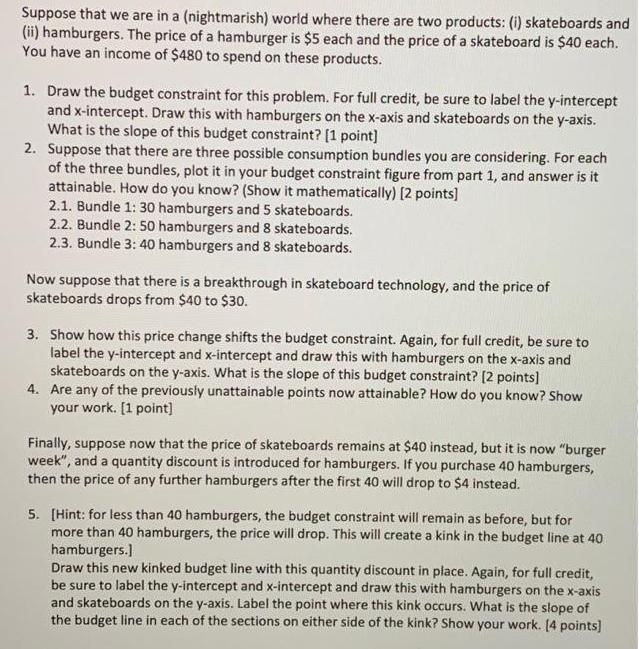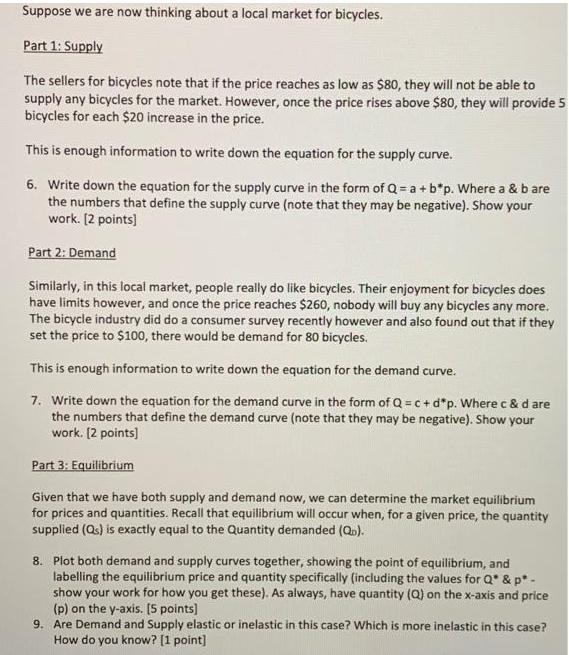Answered step by step
Verified Expert Solution
Question
1 Approved Answer
Suppose that we are in a (nightmarish) world where there are two products: (i) skateboards and (ii) hamburgers. The price of a hamburger is


Suppose that we are in a (nightmarish) world where there are two products: (i) skateboards and (ii) hamburgers. The price of a hamburger is $5 each and the price of a skateboard is $40 each. You have an income of $480 to spend on these products. 1. Draw the budget constraint for this problem. For full credit, be sure to label the y-intercept and x-intercept. Draw this with hamburgers on the x-axis and skateboards on the y-axis. What is the slope of this budget constraint? [1 point] 2. Suppose that there are three possible consumption bundles you are considering. For each of the three bundles, plot it in your budget constraint figure from part 1, and answer is it attainable. How do you know? (Show it mathematically) [2 points] 2.1. Bundle 1: 30 hamburgers and 5 skateboards. 2.2. Bundle 2: 50 hamburgers and 8 skateboards. 2.3. Bundle 3: 40 hamburgers and 8 skateboards. Now suppose that there is a breakthrough in skateboard technology, and the price of skateboards drops from $40 to $30. 3. Show how this price change shifts the budget constraint. Again, for full credit, be sure to label the y-intercept and x-intercept and draw this with hamburgers on the x-axis and skateboards on the y-axis. What is the slope of this budget constraint? [2 points] 4. Are any of the previously unattainable points now attainable? How do you know? Show your work. [1 point] Finally, suppose now that the price of skateboards remains at $40 instead, but it is now "burger week", and a quantity discount is introduced for hamburgers. If you purchase 40 hamburgers, then the price of any further hamburgers after the first 40 will drop to $4 instead. 5. [Hint: for less than 40 hamburgers, the budget constraint will remain as before, but for more than 40 hamburgers, the price will drop. This will create a kink in the budget line at 40 hamburgers.] Draw this new kinked budget line with this quantity discount in place. Again, for full credit, be sure to label the y-intercept and x-intercept and draw this with hamburgers on the x-axis and skateboards on the y-axis. Label the point where this kink occurs. What is the slope of the budget line in each of the sections on either side of the kink? Show your work. [4 points] Suppose we are now thinking about a local market for bicycles. Part 1: Supply The sellers for bicycles note that if the price reaches as low as $80, they will not be able to supply any bicycles for the market. However, once the price rises above $80, they will provide 5 bicycles for each $20 increase in the price. This is enough information to write down the equation for the supply curve. 6. Write down the equation for the supply curve in the form of Q = a + b*p. Where a & b are the numbers that define the supply curve (note that they may be negative). Show your work. [2 points] Part 2: Demand Similarly, in this local market, people really do like bicycles. Their enjoyment for bicycles does have limits however, and once the price reaches $260, nobody will buy any bicycles any more. The bicycle industry did do a consumer survey recently however and also found out that if they set the price to $100, there would be demand for 80 bicycles. This is enough information to write down the equation for the demand curve. 7. Write down the equation for the demand curve in the form of Q = c + d*p. Where c & d are the numbers that define the demand curve (note that they may be negative). Show your work. [2 points] Part 3: Equilibrium Given that we have both supply and demand now, we can determine the market equilibrium for prices and quantities. Recall that equilibrium will occur when, for a given price, the quantity supplied (Qs) is exactly equal to the Quantity demanded (Q.). 8. Plot both demand and supply curves together, showing the point of equilibrium, and labelling the equilibrium price and quantity specifically (including the values for Q* & p* - show your work for how you get these). As always, have quantity (Q) on the x-axis and price (p) on the y-axis. [5 points] 9. Are Demand and Supply elastic or inelastic in this case? Which is more inelastic in this case? How do you know? [1 point]
Step by Step Solution
★★★★★
3.37 Rating (156 Votes )
There are 3 Steps involved in it
Step: 1
1 Slope Px Py 540 18 2 Bundle 1 is attainable Bundle 2 ...
Get Instant Access to Expert-Tailored Solutions
See step-by-step solutions with expert insights and AI powered tools for academic success
Step: 2

Step: 3

Ace Your Homework with AI
Get the answers you need in no time with our AI-driven, step-by-step assistance
Get Started


